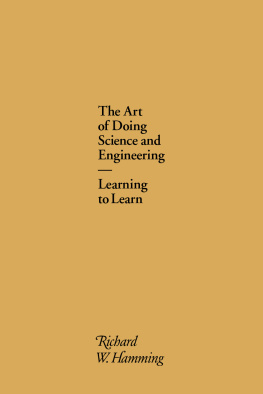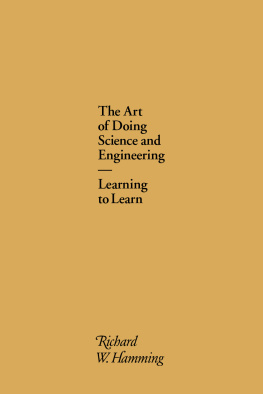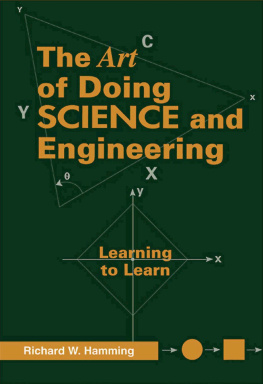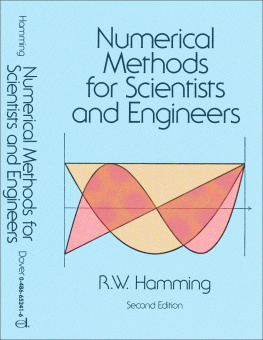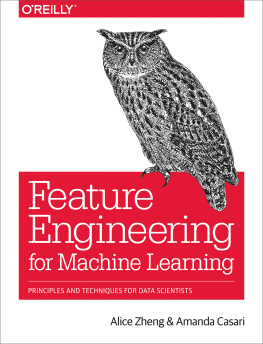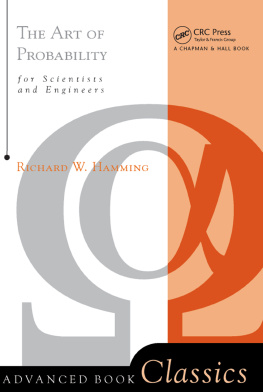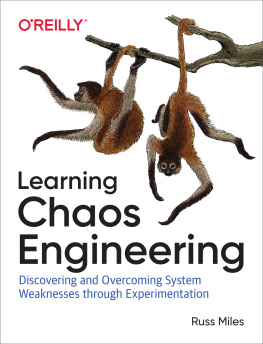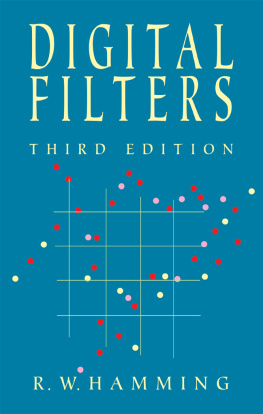Richard Hamming - The Art of Doing Science and Engineering: Learning to Learn
Here you can read online Richard Hamming - The Art of Doing Science and Engineering: Learning to Learn full text of the book (entire story) in english for free. Download pdf and epub, get meaning, cover and reviews about this ebook. publisher: Stripe Press, genre: Religion. Description of the work, (preface) as well as reviews are available. Best literature library LitArk.com created for fans of good reading and offers a wide selection of genres:
Romance novel
Science fiction
Adventure
Detective
Science
History
Home and family
Prose
Art
Politics
Computer
Non-fiction
Religion
Business
Children
Humor
Choose a favorite category and find really read worthwhile books. Enjoy immersion in the world of imagination, feel the emotions of the characters or learn something new for yourself, make an fascinating discovery.
- Book:The Art of Doing Science and Engineering: Learning to Learn
- Author:
- Publisher:Stripe Press
- Genre:
- Rating:4 / 5
- Favourites:Add to favourites
- Your mark:
- 80
- 1
- 2
- 3
- 4
- 5
The Art of Doing Science and Engineering: Learning to Learn: summary, description and annotation
We offer to read an annotation, description, summary or preface (depends on what the author of the book "The Art of Doing Science and Engineering: Learning to Learn" wrote himself). If you haven't found the necessary information about the book — write in the comments, we will try to find it.
The Art of Doing Science and Engineering: Learning to Learn — read online for free the complete book (whole text) full work
Below is the text of the book, divided by pages. System saving the place of the last page read, allows you to conveniently read the book "The Art of Doing Science and Engineering: Learning to Learn" online for free, without having to search again every time where you left off. Put a bookmark, and you can go to the page where you finished reading at any time.
Font size:
Interval:
Bookmark:
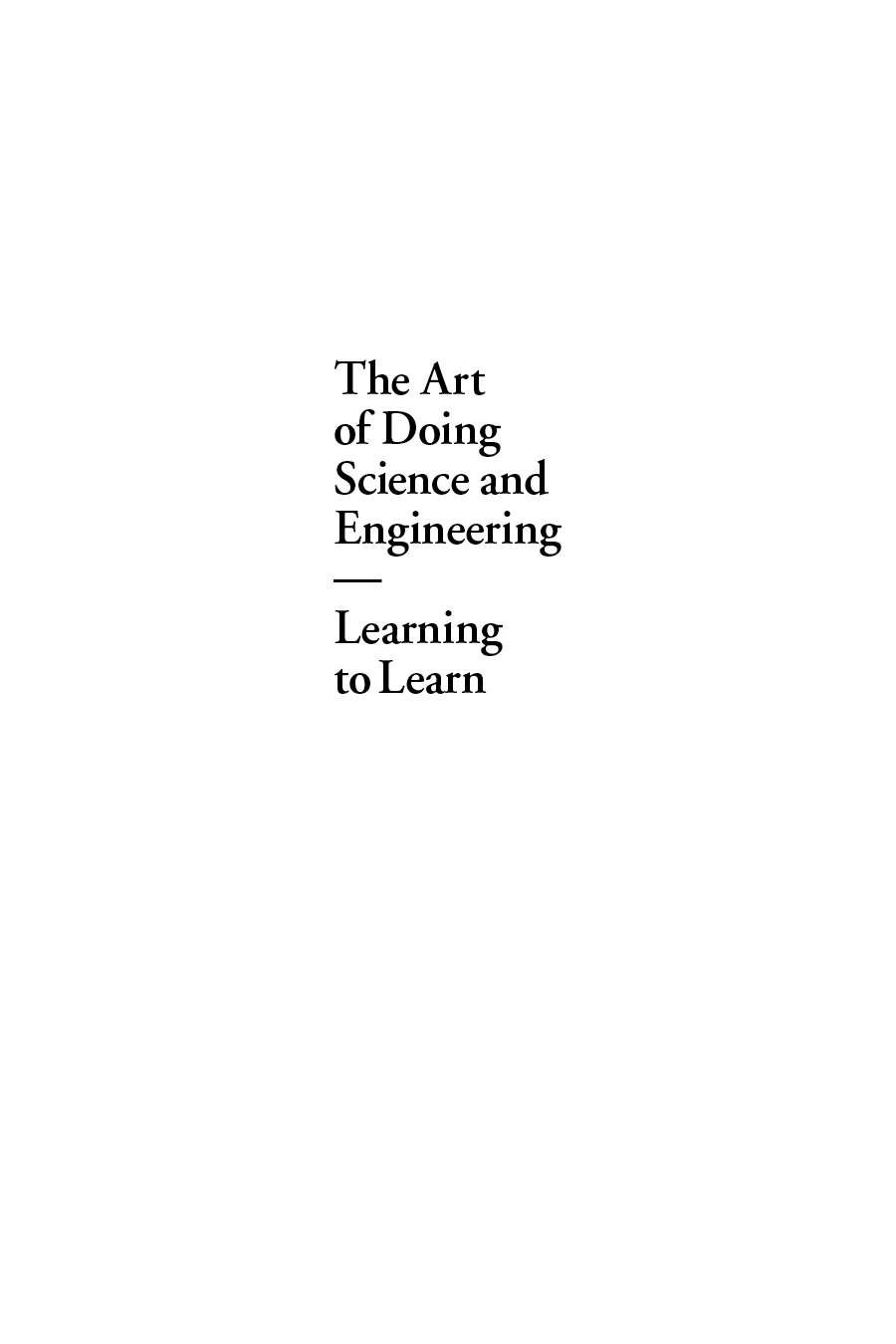
The Art of Doing Science and Engineering: Learning to Learn
2020 Stripe Press
CRC Press edition published 1996
Stripe Press edition published 2020
All rights reserved. No part of this publication may be reproduced or transmitted in any form or by any means, electronic or mechanical, including photocopying, recording or any other information storage and retrieval system, without prior permission in writing from the publisher.
Mathematics proofreading for this edition by Dave Hinterman
Published in the United States of America by Stripe Press / Stripe Matter Inc.
Stripe Press
Ideas for progress
San Francisco, California
press.stripe.com
Printed by Hemlock in Canada
ebook design by Bright Wing Media
ISBN: 978-1-7322651-7-2
Fourth Edition
Like many electrical engineers, I grew up in a world shaped by Richard Hamming. My graduate thesis was based on coding theory; my early career on digital filters and numerical methods. I loved these subjects, took them for granted, and had no idea how they came to be.
I got my first hint upon encountering You and Your Research, Hammings electrifying sermon on why some scientists do great work, why most dont, why he did, and why you should too. Most thrilling was Hammings vivid image of greatness, and its unapologetic pursuit. Not only was it allowable to aim for greatness, it was cowardly not to. It was the most inspirational thing Id ever read.
The Art of Doing Science and Engineering is the full, beautiful expression of what You and Your Research sketched in outline. In this delightfully earnest parody of a textbook, chapters on Digital Filters and Error-Correcting Codes do not, in fact, teach those things at all, but rather exist to teach the style of thinking by which these great ideas were conceived.
This is a book about thinking. One cannot talk about thinking in the abstract, at least not usefully. But one can talk about thinking about digital filters, and by studying how great scientists thought about digital filters, one learns, however gradually, to think like a great scientist.
Among the most remarkable attributes of Hammings style of thinking is its sweeping range of scale. At the micro level, we see the close, deliberate examination of everyone and everything, from the choice of complex exponentials as basis functions to the number of jokes in an after-dinner speech. Nothing is taken for granted or left unquestioned, but is picked up and turned over curiously, intently, searching for fundamentals.
And then, even in the same sentence, a zoom out to the wide shot, the subject contextualized against the broad scientific landscape, a link in the long chain of history. Just as nothing is taken for granted, nothing is taken in isolation.
For one accustomed to the myopia of day-to-day work in a field, so jammed against the swaggering parade of passing trends that one can hardly see beyond them or beneath them, such shifts in viewpoint are exhilaratinga reminder that information may be abundant but wisdom is rare.
After all, where today can the serious student of scientific creativity observe the master at work, short of apprenticeship? Histories are written for spectators; textbooks teach tools, not craft. We can gather small hints from the loose reflections of Hadamard, the lofty theories of Koestler, the tactical heuristics of Plya and Altshuller.
But Hamming stands alone. Certainly for the thoroughness with which he presents his style of thinking, and more so for explicitly identifying style as a thing that exists and can be learned in the first place. But most of all, for his expectationhis insistencethat the reader is destined to join him in extending the arc of history, to become a great person who does great work. In this tour of scientific greatness, the reader is not a passenger, but a driver in training.
This book is filled with great people doing great work, and to successfully appreciate Hammings expectations, it is valuable to consider exactly what he meant by great people, and by great work.
* * *
In Hammings world, great people do and the rest do not. Hammings heroes assume almost mythical stature, swashbuckling across the scientific frontier, generating history in their wake. And yet, it is well-known that science is a fundamentally social enterprise, advanced by the intermingling ideas and cumulative contributions of an untold mass of names which, if not lost to the ages, are at least absent from Wikipedia.
Hammings own career reflects this contradiction. He was employed essentially as a kind of internal mathematical consultant; he spent his days helping other people with their problems, often problems of a practical and mundane nature. Rather than begrudging this work, he saw it as the interaction with harsh reality necessary to keep his head out of the clouds, and at best, the continuous production of micro-Nobel Prizes. And most critically, all of his great work, his many celebrated inventions, grew directly out of these problems he was solving for other people.
Throughout, Hamming insisted on an open door, lunched with anyone he could learn from or argue with, stormed in and out of colleagues offices, and otherwise made indisputable the social dimensions of advancing a field.
All this is true. Also true is Hammings personal experience that one cannot work alongside John Tukey, share an office with Claude Shannon, eat lunch with Bardeen and Brattain, get bossed by Bethe and Bode, study the lives of Newton and Einstein, even hang out with Feynman a bit, without being struck by the utter obviousness that these are extraordinary people, whose work has had an extraordinarily discontinuous effect.
Hamming couldnt deny this, but he couldnt merely accept it either. He needed to know where this extraordinariness came from. The joke around Princeton was that John von Neumann was not human, but a demigod who had made a detailed study of humans and could imitate them perfectly. Bad news for any aspiring von Neumanns of more terrestrial stock.
Hammings convictionindeed, obsessionwas the opposite: that this greatness was less a matter of genius (or divinity), and more a kind of virtuosity. He saw these undeniably great figures as human beings that had learned how to do something, and by studying them, he could learn it too.
And he did, or so his narrative goes: against a background of colleagues more talented, more knowledgable, more supported, better equipped along every axis, Hamming was the one to invent the inventions, found the fields, win the awards, and generally transcend his times.
And if he could, then so could anyone. Hamming was always as much a teacher as a scientist, and having spent a lifetime forming and confirming a theory of great people, he felt he could prepare the next generation for even greater greatness. Thats the premise and promise of this book.
Hamming-greatness is thus more a practice than a trait. This book is full of great people performing mighty deeds, but they are not here to be admired. They are to be aspired to, learned from, and surpassed.
* * *
Hamming leaves the definition of great work open, encouraging the reader to pick your goals of excellence and strive for greatness
Font size:
Interval:
Bookmark:
Similar books «The Art of Doing Science and Engineering: Learning to Learn»
Look at similar books to The Art of Doing Science and Engineering: Learning to Learn. We have selected literature similar in name and meaning in the hope of providing readers with more options to find new, interesting, not yet read works.
Discussion, reviews of the book The Art of Doing Science and Engineering: Learning to Learn and just readers' own opinions. Leave your comments, write what you think about the work, its meaning or the main characters. Specify what exactly you liked and what you didn't like, and why you think so.

